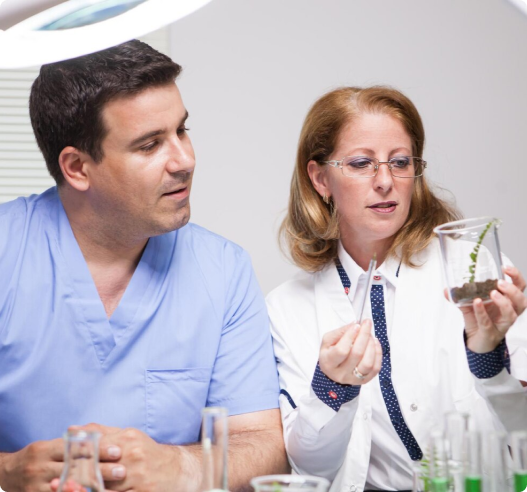GMP & GMP-Like Plasmid Manufacturing
Plasmid Manufacturing

| GMP-Grade | GMP-Like | Research-Grade |
Lower the cost and expedite your project timeline with Applied StemCell's complete GMP/GMP-like plasmid DNA development platform. At ASC, our team can design and optimize your vector, provide expansion and banking services (working and master cell banks), and perform comprehensive QC checks prior to product delivery.
Whether you need plasmid DNA for your drug discovery research or pre-clinical studies, ASC has you covered! If you would like to learn more about how you can start building your unique plasmid DNA, contact us today to schedule your free consultation.
Advantages
- Tech transfer, optimization, cell banking with 24/7 monitoring, and adequate QC checks
- From RUO to Commercial stage
- Competitive Pricing
- Research, GMP-like & GMP Grade
- pDNA formats: frozen glycerol stock or stabs for cultures
- Inquire about pDNA formats we accept
- Fully customizable service
| Research Grade | GMP-Like | GMP | |
| Vector Characterization | Yes | Yes | Yes |
| Optimization (e.g., vector, culture conditions, etc.) | -- | Yes | Yes |
| Cell Banking (Working & Master Cell Banks) | -- | Optional | Yes |
| Quality - GMP Guidelines | -- | Yes | Yes |
| Documentation | -- | Yes | Yes |
| Segregated Production | -- | Yes | Yes |
| Aseptic Process On Downstream | -- | Optional | Yes |
| Designated cGMP Suite (Cleanroom) | -- | -- | Yes |
| Environmental Monitoring | -- | Yes | Yes |
| Storage & Retention | Optional | Optional | Yes |
| Deliverables Include Comprehensive QC Analysis | -- | Yes | Yes |
Products and Services
| Catalog ID# | Product Name | Price | |
|---|---|---|---|
|
|
|||
Technical Details
GMP & GMP-Like Quality Control Analysis
QC Method A260/280 Ratio Purity UV Appearance Visual Inspection DNA Homogeneity EtBr AGE Endotoxin LAL Identity RE Digest AGE Plasmid Identity Sequencing (Nanopore) whole plasmid Residual Host Genomic DNA qPCR Residual Host Protein Qubit Protein Residual Host RNA Qubit RNA Sterility USP <71> Mycoplasma USP<63> *** What's the difference? GMP projects are conducted in a designated cGMP suite (Cleanroom).
Research-Grade Quality Control Analysis
QC Method A260/280 Ratio Purity UV Concentration --
Application Notes
Areas of Application CAR-T/CAR-NK Therapy DNA Synthesis Genome Editing (CRISPR/TARGATT) Transfection Screening Viral Vector Cloning mRNA Production
Frequently Asked Questions
What is GMP-like plasmid manufacturing?
GMP-like plasmid manufacturing refers to the production of plasmid DNA under conditions that follow GMP (Good Manufacturing Practice) guidelines. Plasmids are circular DNA molecules that can be used as a vector to transfer genes into cells, making them an essential component in gene therapy and genetic engineering applications. The GMP-like plasmid manufacturing process involves strict quality control measures, including the use of GMP-grade raw materials, validated production processes, and a controlled environment. The plasmid DNA is manufactured under conditions that ensure the purity, identity, and potency of the final product. The process also includes documentation and record-keeping to enable traceability and accountability of the final product. While GMP-like plasmid manufacturing does not follow the full GMP regulations required for clinical trials, it is a step towards ensuring that the plasmid DNA used in preclinical studies is of high quality and meets regulatory standards. This process helps to minimize the risks associated with the use of low-quality plasmid DNA, such as contamination or inconsistent results. Overall, GMP-like plasmid manufacturing is an essential component of the development and production of gene therapies and other genetic engineering applications, as it ensures that the plasmid DNA used is of high quality, purity, and consistency.
For plasmid quality control, what is the nanopore technology?
Nanopore technology is a method of DNA sequencing that uses protein nanopores to identify individual nucleotides as they pass through the nanopore. In nanopore technology, a DNA molecule is passed through a tiny pore, which is typically made of a protein called a nanopore. As the DNA strand passes through the pore, it disrupts the flow of ions across the pore, creating a measurable signal. The sequence of nucleotides in the DNA molecule can be determined by analyzing the changes in the ion current as each nucleotide passes through the pore. One of the advantages of nanopore technology is that it can sequence DNA in real time, providing a rapid and portable method of DNA sequencing. Nanopore sequencing can also be used to detect modifications to the DNA molecule, such as methylations or other chemical modifications, which can provide important information about gene expression and epigenetic regulation.
What is Endotoxin-free plasmid?
Endotoxin-free plasmid refers to plasmid DNA that is free from endotoxins, which are lipopolysaccharides found in the outer membrane of Gram-negative bacteria. Endotoxins can cause adverse reactions in humans and animals, leading to fever, inflammation, and other symptoms. In the context of plasmid DNA used in research, endotoxins can interfere with the accuracy of experimental results, so it’s essential to use plasmids that are free from endotoxins. Endotoxin-free plasmids are typically produced using special purification techniques that remove endotoxins from the final product. These techniques involve using reagents and resins that bind to endotoxins and remove them from the plasmid DNA. Endotoxin-free plasmids are commonly used in various fields of research, including gene therapy, vaccine development, and protein expression studies.
What is research grade plasmid DNA Manufacturing?
Plasmids can be applied in basic research and pre-clinical studies. The development process lacks traceability.
What is the GMP-like DNA plasmid and GMP DNA plasmid?
For GMP-like plasmid development only key elements of GMP protocols/QC are adopted for plasmid construction.
What Applied StemCell is offering for DNA plasmid manufacturing?
Research-grade and GMP-like DNA plasmid development. To learn more, contact us today.



 Custom In Vivo Assay Services
Custom In Vivo Assay Services